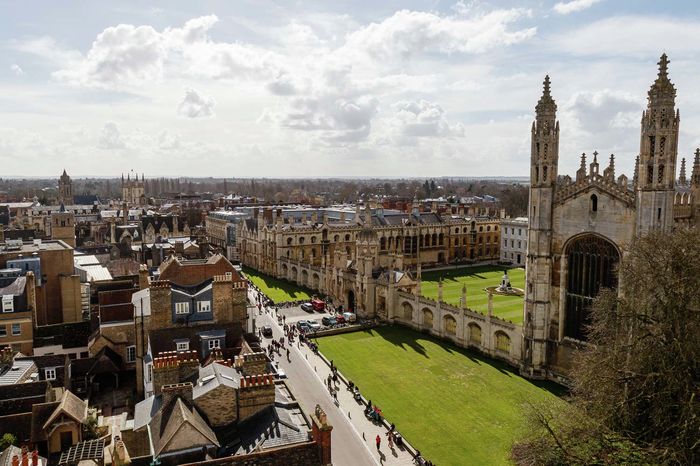Five years of University admissions statistics reveals the disadvantages faced by state-educated students
Varsity analysis of five years of admissions data reveals the disadvantages faced by state school applicants and the misrepresentations of state school admissions in University statistics
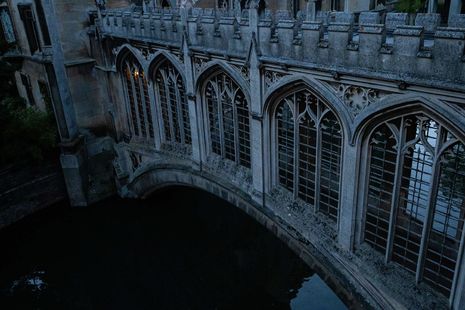
A Freedom of Information (FOI) request passed onto Varsity shows the disparities in application and acceptance rates based on pupils’ educational background, revealing that these rates are lower for students with no grammar or private school backgrounds. The data from the FOI also brings into question the ways in which students are categorised based on their prior education.
The FOI data covers admissions statistics for UK students in all 31 colleges between 2014 and 2019. The data breaks up applications and acceptances in each college by the type of educational institution they attended (such as comprehensive, grammar, private, academy).
Data from the FOI also records both the L2 and L3 school status of students. L2 education refers to the type of school at which a student sat their GCSE or regional equivalent examinations, whereas L3 corresponds to A-level or equivalent education.
Overrepresentation of applicants from private and grammar schools
Only 48% of Cambridge applicants have not attended a private or grammar school at either L2 or L3, as shown in Figure 1. Applicants from private or grammar schools represent a majority of applicants to the University.
Students who attended private schools at L3 make up the second largest group with 29% of applicants with a further 3.4% attending private schools at L2. Amongst this, students who attended private education for L2 but transferred to a state school for L2 are counted towards the University’s state school admission statistics.
Finally, 17.6% of applicants attended a grammar school at L2 before transferring to a state school and another 2.4% transferred from non-grammar state schools at L2 into grammar schools for L3.

Furthermore, the proportion of acceptances of students with grammar and private backgrounds is higher than the corresponding proportion of applications.
Figure 2 shows that acceptances for those who attended grammar schools at L2 increased by 2.4% compared to the number of grammar school applicants. In total, 20% of the accepted cohort between 2014 and 2019 were students who had attended a grammar school at L2 but a state comprehensive at L3.
The biggest increase in acceptances versus admissions occurred for students who had attended a private school at L3; these students comprised 35% of acceptances but only 29% of applications.
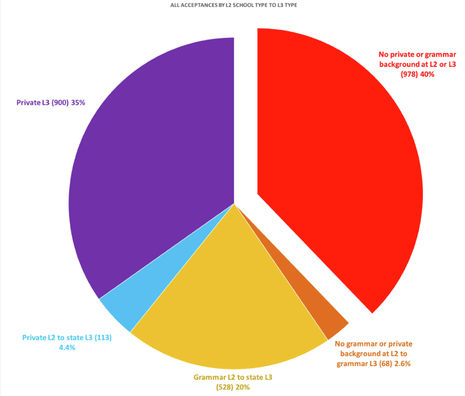
Meanwhile, the proportion of acceptances for those with no private or grammar school background was lower than applications by 8%.
This data indicates that more students from private and grammar school backgrounds apply to Cambridge than are represented in the general population as only around 6.5% of school children in the UK attend private schools while only 5% of state-educated pupils in England attend grammar schools.
Beyond applications, students with a private or grammar school education are also overrepresented in yearly cohorts as they comprise larger portions of the acceptance pool than of the applications pool.
Misrepresentation and Bias in L2 Education
The University recently announced that this year's intake will contain a record number of state school students. According to preliminary data, an estimated 70% of students from the UK will come from the maintained sector compared to 68.7% in last year's incoming cohort.
However, currently University admissions categorise applicants according to L3 education type, meaning if someone takes A Level or equivalent qualifications at a state school, they are recorded as a state applicant and admission.
Admissions departments also have access to applicant’s L2 education type which is used to provide contextual information in the consideration of GCSE grades.
While colleges do record applicant’s L2 status this is not used to categorise students. This means that a student who attended a state school for their A-levels is recorded as a state school student regardless of their L2 education. Thus, a student who attended a private school up until GCSE and then switched to a state comprehensive or grammar school to complete their A-levels is recorded as a student from the maintained sector by admissions departments.
Students who attended a private school for L2 but are recorded by the University as a state-school applicant because of their L3 education are the most successful category of applicants. Examining acceptances as a percentage of applications, students in this category have a success rate of 33.9% across all colleges, compared to an average success rate of 26.4% for all applicants.
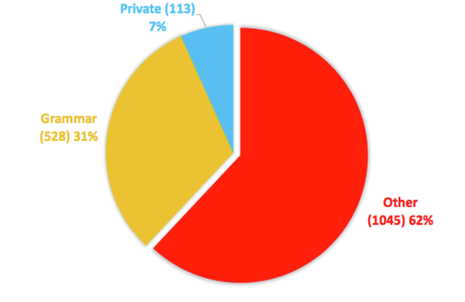
The category of students with the lowest rate of successful applications were those students who have neither grammar nor private education at either L2 or L3. Applications from students in this category only have an average success rate of 20.9%.
This data also suggests that, by solely categorising students by their L3 education, the University doesn't seem to fully represent the proportion of students with state education. As shown in Figure 3, one in fourteen acceptances listed by the University as state educated are, in fact, educated at a private school up until L3. Furthermore, another 31% of students listed as state educated are educated at grammar schools for L2.
Despite the considerable differences between grammar and state comprehensive schools, the University only maintains a distinction between the ‘maintained sector’ and private schools.
Maintained sector refers to any school that is funded and controlled by the local education authority; this includes both state comprehensives and grammar schools. By using this less granular distinction the University and colleges are able to hold that over 60% of admissions are state school educated without acknowledging that a large number of these students have either received private school or grammar education at some point in their schooling career.
The University’s measures of diversity have come under criticism in the past as a report by the Higher Education Policy Institute (HEPI) thinktank found that Cambridge was the most unequal University according to different measures.
HEPI compared the number of students Cambridge accepted from the five different POLAR (Participation of Local Area) regions to a ‘perfect’ distribution in which the same number hailed from each region. This revealed that Cambridge was the furthest from the ideal distribution of any British university LINK.
Despite the fact that the methodology of this report came under heavy criticism from the University for failing ‘to reflect the diversity of our society’, this does suggest that a broader spectrum of measures and better classification of students can yield a more nuanced picture of the diversity of the University’s student population.
How do Colleges Compare?
Admissions data obtained by Varsity also allows for comparison across colleges on a variety of criteria. Comparing, first, according to the proportion of applicants with no grammar or private education: the colleges with the joint lowest levels of applications from this category are Gonville and Caius and St John’s. Only 40% of applicants to these colleges are from this background; 8% lower than the college average.
A spokesperson for St John’s told Varsity that “St John’s College has received around 60 percent of applications from the maintained school sector in the past three years.”
They continued: “We are working very hard to increase applications from students at maintained schools and the numbers are increasing every year. We have a full-time Schools Liaison and Access Officer and continually review the effectiveness of our extensive outreach and widening participation initiatives.”
However, this fails to acknowledge the overrepresentation of grammar school students in the college’s maintained school category as 23% of the total intake, over half of the college's maintained sector applicants, have attended a grammar school at L3.
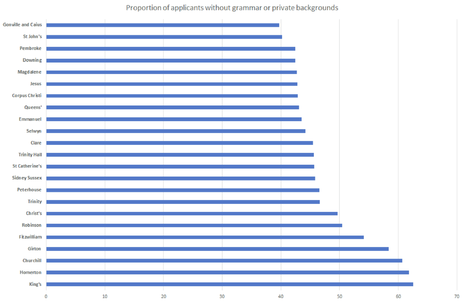
Colleges currently categorise schools as either maintained or private but do not distinguish between different schools within this category. St John’s did not respond to a Varsity question as to why only 40% of its applicants have no private or grammar education.
Likewise a spokesperson for Gonville and Caius told Varsity that “the College has increased its direct applications from both the Maintained and Independent sectors in recent years, and is keen to attract applications from good students of all backgrounds.”
“The College has been working hard across its large link areas to provide advice and encouragement to Maintained Sector students to apply to Cambridge.”
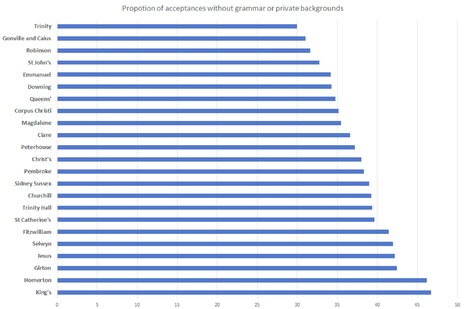
The spokesperson did not comment on any of Varsity’s main findings as reported in this article.
St John’s and Gonville and Caius are then followed by Pembroke and Downing in having the lowest proportion of applicants without grammar or private education, each with 42%.
Magdalene, Jesus, and Corpus Christi follow with 43% of the college’s applicants hailing from non-grammar state schools.
The college with the highest proportion of applicants from this category is King’s College, with 63% of applicants having no public or grammar education, followed by Homerton with 62%.
Considering admissions of students with no private or grammar education, a similar picture emerges. Trinity, despite the fact that 47% of its applicants have no private or grammar education, only takes 30% of its total acceptances from this group, as seen in Figure 5. Trinity is yet to respond to Varsity’s request for comment.
Gonville and Caius has the second lowest proportion of acceptances of students in this category at 31%, followed by Robinson with 32%.
King’s College also has the highest proportion of acceptances in this category; with students with no private or grammar education making up 47% of admissions.
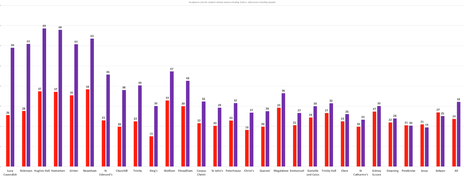
However, the proportion of non-private or grammar educated applicants admitted to King's is 16 percentage points lower than the proportion of non-private or grammar in the College's applicant pool, one of the largest differences of any college.
Speaking to Varsity, a spokesperson said “King’s has long been at the forefront of UK state school access, and the College undertakes a wide range of initiatives designed to encourage and support applicants from economically and educationally disadvantaged backgrounds. This data-set provides welcome nuance that will help inform our ongoing programme of activities and combat entrenched inequality in years to come.”
The college with the highest disparity between applications and admissions for students from non-private or grammar backgrounds is Churchill. Although students in this category make up an average 61% of applications, they represent only 39% of admissions. Churchill is yet to respond to Varsity’s request for comment.
On this criteria Churchill is followed by Robinson with a 19% average difference, and then by Trinity with a 17% difference.
General trend favouring applicants from private and grammar schools
Data from the FOI shows that, even though a majority of students in the country attend non-private and non-grammar educational institutions, only 10 colleges - Lucy Cavendish, Wolfon, St. Edmund’s, Girton, Homerton, Newnham, Murray Edwards, King’s, Churchill and Fitzwilliam - receive more than 50% of their applications from these students.
Furthermore, no college’s cohort is made up by a majority of students with no private and no grammar education.
More generally, Figure 6 shows that students with private school backgrounds are favoured in terms of acceptance rates. Overall, the average acceptance rate for students with no private schooling is 24% while for those with private schooling it is 32%. This includes students who have attended a private institution at either GCSE or A-Level.
Some colleges, namely Lucy Cavendish, Robinson, Hughes Hall and Homerton, have more than a 30% point difference between successful applications for those with and without private schooling.
When broken down further, it is also evident that in colleges like Pembroke, Jesus and Selwyn, where the acceptance rate for non-privately educated students is similar to privately educated applicants, this is due to acceptances of students from grammar schools. In all three of these colleges, pupils who have gone to grammar schools but not private schools have a higher acceptance rate than those who have gone to both private and state schools.
Among no colleges do pupils, with no private or grammar school education, have the highest acceptance rate when broken down according to educational institutions attended by offer-holders.
The University has not responded to Varsity’s request for comment.
 News / Cambridge cosies up to Reform UK30 November 2025
News / Cambridge cosies up to Reform UK30 November 2025 News / University Centre hangs in the balance28 November 2025
News / University Centre hangs in the balance28 November 2025 News / Jack Peters wins Union presidency in contested race1 December 2025
News / Jack Peters wins Union presidency in contested race1 December 2025 News / Protesters accuse sustainability institute of ‘greenwashing’1 December 2025
News / Protesters accuse sustainability institute of ‘greenwashing’1 December 2025 News / Uni registers controversial new women’s society28 November 2025
News / Uni registers controversial new women’s society28 November 2025

